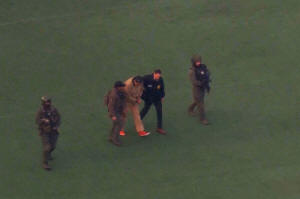Maduro says 'I was captured' as he pleads not guilty to drug trafficking
charges
[January 06, 2026]
By MICHAEL R. SISAK, LARRY NEUMEISTER and ERIC TUCKER
NEW YORK (AP) — A defiant Nicolás Maduro declared himself "the president
of my country” as he protested his capture and pleaded not guilty Monday
to federal drug trafficking charges that the Trump administration used
to justify removing him from power in Venezuela.
“I was captured,” Maduro said in Spanish as translated by a courtroom
interpreter before being cut off by the judge. Asked later for his plea
to the charges, he stated: "I am innocent. I am not guilty. I am a
decent man, the constitutional president of my country.”
Maduro’s court appearance in Manhattan, his first since he and his wife,
Cilia Flores, were seized from their Caracas home Saturday in a stunning
middle-of-the-night military operation, kicked off the U.S. government’s
most consequential prosecution in decades of a foreign head of state.
She also pleaded not guilty.
The criminal case is unfolding against a broader diplomatic backdrop of
an audacious U.S.-engineered regime change that President Donald Trump
has said will enable his administration to “run” the South American
country.
Maduro, 63, was brought to court under heavy security early Monday —
flown by helicopter to Manhattan from Brooklyn, where he is jailed, and
then driven to the courthouse in an armored vehicle. He and Flores were
led into court just before noon. Both were in leg shackles and
jail-issued garb, and both put on headsets to hear the English-language
proceeding as it was translated into Spanish.
As Maduro left the courtroom, a man in the audience denounced him as an
“illegitimate” president.

A legal fight begins
As a criminal defendant in the U.S. legal system, Maduro will have the
same rights as any other person charged with a crime in the country —
including the right to jury trial. But, given the circumstances of his
arrest and the geopolitical stakes at play, he’ll also be nearly — but
not quite — unique.
That was made clear from the outset as Maduro, who took copious notes
throughout the proceedings and wished Happy New Year to reporters as he
entered the courtroom, repeatedly pressed his case that he had been
unlawfully abducted.
“I am here kidnapped since Jan. 3, Saturday," Maduro said, standing and
leaning his tall frame toward a tabletop microphone. “I was captured at
my home in Caracas.”
U.S. District Judge Alvin Hellerstein, a 92-year-old jurist who was
appointed to the federal bench in 1998 by Bill Clinton, interrupted him,
saying: “There will be a time and place to go into all of this."
Hellerstein added that Maduro’s lawyer could do so later.
“At this point in time, I only want to know one thing," the judge said.
"Are you Nicolás Maduro Moros?”
“I am Nicolás Maduro Moros,” the defendant responded.
Maduro’s lawyer, Barry Pollack, said he expects to contest the legality
of his “military abduction."
Pollack, a prominent Washington lawyer whose clients have included
WikiLeaks founder Julian Assange, said Maduro is “head of a sovereign
state and is entitled to the privileges and immunities that go with that
office.”

Panamanian strongman Manuel Noriega unsuccessfully tried the same
immunity defense after the U.S. captured him in a similar military
invasion in 1990. But the U.S. doesn’t recognize Maduro as Venezuela’s
legitimate head of state — particularly after a much-disputed 2024
reelection.
Flores, who identified herself to the judge as “first lady of the
Republic of Venezuela,” had bandages on her forehead and right temple.
Her lawyer, Mark Donnelly, said she suffered “significant injuries”
during her capture.
A 25-page indictment accuses Maduro and others of working with drug
cartels to facilitate the shipment of thousands of tons of cocaine into
the U.S. They could face life in prison if convicted.
Among other things, the indictment accuses Maduro and his wife of
ordering kidnappings, beatings and murders of those who owed them drug
money or undermined their drug trafficking operation. That included the
killing of a local drug boss in Caracas, the indictment said.
[to top of second column]
|

This image taken from video shows Venezuelan President Nicolas
Maduro being escorted to board a helicopter for transport to
Manhattan Federal Court, Monday, Jan. 5, 2026, in New York. (WABC
via AP)

Outside the courthouse, police separated those protesting the U.S.
military action from pro-intervention demonstrators. Inside the
courtroom, as the proceeding wrapped up and Maduro prepared to
leave, 33-year-old Pedro Rojas stood up and began speaking
forcefully at him in Spanish.
Rojas said later that he had been imprisoned by the Venezuelan
regime. As deputy U.S. marshals led Maduro from the courtroom, the
deposed leader looked directly at the man and shot back in Spanish:
“I am a kidnapped president. I am a prisoner of war.”
Demands for Maduro's return
Trump said Saturday the U.S. would “run” Venezuela temporarily and
reiterated Sunday night that “we're in charge,” telling reporters
“we're going to run it, fix it.”
Secretary of State Marco Rubio tried to strike a more cautious tone,
telling Sunday morning talk shows that the U.S. would not govern the
country day-to-day other than enforcing an existing ” oil
quarantine.”
Before his capture, Maduro and his allies claimed U.S. hostility was
motivated by lust for Venezuela’s rich oil and mineral resources.
Trump has suggested that removing Maduro would enable more oil to
flow out of Venezuela, but oil prices rose 1.7% on Monday. There are
uncertainties about how fast oil production can be ramped up in
Venezuela after years of neglect, as well as questions about
governance and oversight of the sector.
Venezuela’s new interim leader, Delcy Rodríguez, has demanded that
the U.S. return Maduro, who long denied any involvement in drug
trafficking — although late Sunday she struck a more conciliatory
tone in a social media post, inviting collaboration with Trump and
“respectful relations” with the U.S.
Rodríguez was sworn in on Monday by her brother, National Assembly
leader Jorge Rodríguez.

“I come with sorrow for the suffering inflicted upon the Venezuelan
people following an illegitimate military aggression against our
homeland,” she said with her right hand up. “I come with sorrow for
the kidnapping of two heroes."
Maduro’s son and Venezuelan congressman Nicolás Maduro Guerra warned
on Monday that his father's capture could set a dangerous precedent
globally and demanded that his parents be returned.
“If we normalize the kidnapping of a head of state, no country is
safe. Today it’s Venezuela. Tomorrow it could be any nation that
refuses to submit. This is not a regional problem. It is a direct
threat to global political stability,” Maduro Guerra said
Also Monday, the United Nations Security Council held an emergency
meeting, with the top U.N. official warning that America may have
violated international law with its unilateral action. The world
body also spotlighted the profound humanitarian needs in Venezuela.
Its people have endured a yearslong, complex economic crisis.
___
Tucker reported from Washington. Associated Press writers Regina
Garcia Cano in Caracas, John Hanna in Topeka, Kansas, Megan Janetsky
in Mexico City, Farnoush Amiri and Jennifer Peltz at the United
Nations, Josh Boak in Baltimore, Maryland, Darlene Superville aboard
Air Force One and Joshua Goodman in Miami contributed to this
report.
All contents © copyright 2026 Associated Press. All rights reserved
 |